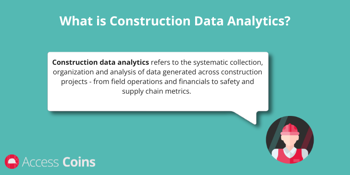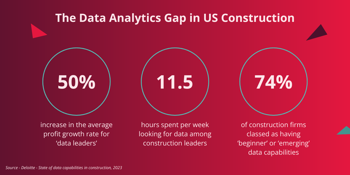Construction Data Analytics: A Practical Guide for Contractors
Construction firms today face mounting pressure to deliver projects faster, safer and more profitably. Yet most contractors still underutilize the data they generate daily.
With studies suggesting that US construction loses over $1 billion annually due to poor decisions based on bad and incomplete data, the stakes are high.
This guide offers practical, strategic insights for construction leaders on how to harness construction data analytics to drive delivery and protect profit margins.

What Is Construction Data Analytics?
Construction data analytics refers to the systematic collection, organization and analysis of data generated across construction projects - from field operations and financials to safety and supply chain metrics.
When used effectively, it enables leaders to:
- Make informed, proactive decisions
- Identify risks before they escalate
- Optimize resource allocation
- Improve client satisfaction and win rates

Why Construction Leaders Must Prioritize Construction Data Analytics
A 2023 study by Deloitte and Autodesk found that companies classified as “data leaders” see a 50% higher profit growth rate than their peers, yet over 80% of construction firms only analyze a third of the data they collect.
Key benefits of embracing data analytics in construction:
- Faster decision-making: Real-time dashboards reduce time spent searching for data.
- Improved forecasting: Predictive analytics help anticipate delays, cost overruns, and safety risks.
- Competitive edge: Firms using ERP systems are twice as likely to be data-driven.
- Predictive insights: Analytics tools look at reports from past projects to help you forecast future ones more accurately.
- Cost control: With data analytics, you can assess your budget documents to identify and correct possible cost overruns, keeping spending in check.
- Resource allocation: Analytics tools assess your current material, labor, and equipment inventory and help you allocate resources efficiently.
- Proactive risk management: Data analytics tools can identify possible supply chain disruptions, scope creep and other incidents that could disrupt operations.
Practical Construction Data Strategies for Leaders
Establish a Single Source of Truth
Data silos are a major barrier to efficiency. Centralizing data across departments - including finance, operations and field service - ensures consistency and accessibility.
Implement a construction-specific ERP platform like Access Coins, which integrates project management, financials, and field service into one unified system.
Use Custom Dashboards for Role-Specific Insights
Tailored dashboards empower leaders to focus on what matters most:
- CFOs: Cash flow, profitability, cost variance
- COOs: Schedule adherence, resource utilization
- Project Managers: Risk flags, daily progress, safety metrics
Dashboards should be real-time, mobile-accessible and customizable to support fast, informed decisions.
Track High-Impact KPIs
Focus on metrics that align with strategic goals:
- Project profitability
- Schedule adherence
- Safety incident rate
- Change order frequency
- Cash flow trends
ERP platforms can automate KPI tracking and visualize performance over time.
Leverage Predictive Analytics for Risk Management
Predictive analytics empowers construction leaders to anticipate and mitigate risks before they impact project outcomes. By analyzing historical and real-time data, these tools can forecast cost overruns, supply chain disruptions, and safety.
This forward-looking approach reduces reactive firefighting and supports more strategic, confident decision-making across the business.
Foster a Data-Driven Culture
Upskilling internal teams in data literacy, guided by leadership buy-in, can transform operations.
- Offer training on analytics tools and dashboards
- Encourage feedback and iterative improvements
- Celebrate data-driven wins to reinforce adoption

Turning Data into Action
Ready to turn your construction data into better operational decisions? Here’s the technology you’ll need to make it happen:
- Centralized database: To create a single source of truth and avoid inconsistencies, you’ll need to store all your data in one central location.
- Automated data capture: Look for tools that automatically capture data from your operations, rather than requiring manual entry. This saves your team time and minimizes errors.
- Advanced reporting and analytics tools: Go beyond basic spreadsheets with tools that provide granular reports, detailed analytics charts, and helpful insights.
- Customizable dashboards: Opt for an ERP platform with customizable features that can be tailored to your operational needs.
- Predictive capabilities: Take a proactive approach by choosing analytics tools with predictive capabilities. This will help you forecast what future projects will look like and stay ahead of possible challenges.
Build a Smarter, Data-Driven Future with Access Coins ERP
Explore how Access Construction ERP can help your firm centralize data, automate insights, and lead with confidence.

 UK
UK
 AU & NZ
AU & NZ
 SG
SG
 MY
MY
 IE
IE







